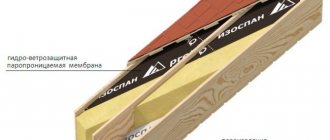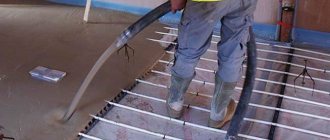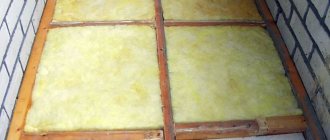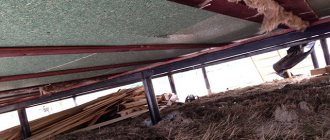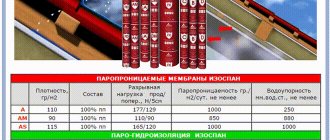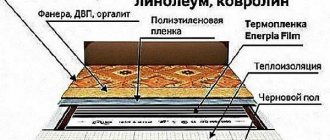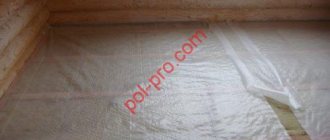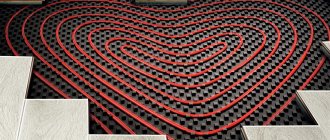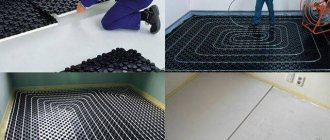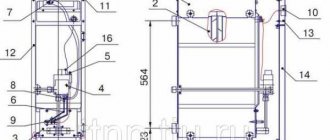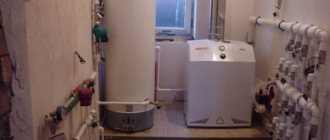Wood and humidity are incompatible things. Moisture has a negative impact on any wooden products. Even in small quantities, it gradually penetrates the structure of the tree and destroys it from the inside, activates the processes of decay, and due to increased humidity, mold and mildew appear on wooden products over time. When installing wooden floors in a house - especially if they are laid on the lower floor - you should take care of high-quality vapor barrier. A membrane material such as Izospan B has proven itself well, instructions for use for flooring in a wooden house are presented in this article.
Izospan B: instructions for use for floors in a wooden house
Izospan V, 70 sq. m.
Why is vapor barrier so important?
Vapor barrier is a series of measures that imply, when installing any building structure, the laying of special materials that protect this structure from the penetration of moisture, steam, and the formation of condensation. In general, vapor barrier is not complete protection against water, but it can protect building elements from the formation of condensation moisture in ceilings, beams and similar structures.
Vapor barrier of the floor in a wooden house
Floors in wooden houses are often laid directly on the top layer of soil, but this is a complete violation of installation technology. Such negligence can lead to fairly rapid destruction of wooden foundations. Wood under the influence of excess dampness quickly becomes unusable - moisture penetrates the structure of the material and begins to destroy it from the inside, rotting processes develop, and pockets of mold and mildew form on the surface.
Example of mold on wooden surfaces
At the same time, not only pure water becomes dangerous for wooden structures, but also its vapors that arise during the evaporation of liquids - for example, when the soil under the floor dries out, in the kitchen during cooking, while mopping or doing laundry. Indicators of atmospheric pressure and temperature in the environment are quite changeable, and it is because of these changes that condensation begins to form on the surface of wood (and indeed any materials).
Attention! Floors in any building, and especially in a residential building, are exposed to the negative effects of dampness both above and below - from the ground and from inside the house. It is especially important to protect the foundation in a wooden house, that is, in a low-rise building.
If you take care of installing a vapor barrier, the process of working with which is not at all complicated, then you can avoid a lot of negative consequences. At the same time, the advantage of such materials is that they are capable of allowing air to pass through, and there is no need to be afraid that the house will not “breathe”.
Vapor barrier for floors in a private house
Izospan C, D
Marking C indicates that the material is well suited for insulating insulation under the roof. It is often used instead of a waterproofing substrate under metal tiles. It is also laid when arranging concrete floors in places where humidity exceeds specified standards.
Marking D indicates that the insulator has good UV resistance. This circumstance and the fact that the material has greater strength allows it to be used as a temporary roof. Otherwise, it is used like the previous insulator.
There is no need to guess which side to lay the Izospan with these markings on. The materials also have a rough surface on one side. So she should look into the room. And the smooth side must be adjacent to the insulation.
Stages of vapor barrier installation Source krepezhinfo.ru
Izospan for flooring in a wooden house
The membrane material Izospan will help to protect floor elements in the house made of wood. It has a special structure that will help protect any wooden structures from exposure to steam and moisture.
Types of material
Izospan in general is a special material, which is a membrane that reliably protects various structures from the effects of external environmental factors - wind, steam, precipitation, moisture, including condensation. Thanks to it, the tree will be reliably protected from the premature onset of rotting processes.
Table of material characteristics Izospan
Technical characteristics of Izospan:
- it is not afraid of exposure to ultraviolet rays and copes well with their reflection;
- durable, copes well with some type of mechanical loads, even if it is exposed regularly;
- has an antioxidant layer;
- moisture-resistant material that retains the ability to resist moisture throughout the entire period of use;
- not afraid of exposure to positive or negative temperatures;
- can be used in any type of structure.
Vapor barrier film Izospan V
On a note! Certain types of Izospan have not only vapor barrier properties. They can act as a heat-retaining material - usually this Izospan has a foil layer.
Izospan is not a completely waterproof material. On the contrary, it helps the steam escape, due to which condensation does not accumulate on the material or wooden surfaces covered by it.
Izospan B - sample
Choosing a vapor barrier
In the process of arranging floors and other enclosing structures of a wooden house, it is necessary to select and buy one or another type of vapor barrier film. Considering the variety of types and offers on the market, a logical question arises: “which vapor barrier is better?” The answer to this cannot be unambiguous, since the correct choice is made only based on compliance with the following requirements:
- Firstly, the technical characteristics of the vapor barrier itself.
- Secondly, the operational characteristics of the room or fence where the vapor barrier will be installed, and their compliance with the previous paragraph.
- Thirdly, the cost of the film itself.
- Fourthly, the volume and price of installation work (it was previously mentioned that polyethylene/propylene films, according to the manual, require a ventilation gap, which complicates the installation of a wooden floor).
Practical installation recommendations
It is better to lay the floor on transverse beams - logs. In this case, the ceiling itself will have a spherical structure - a kind of motley “Napoleon pie”. The layer diagram looks like this:
1. Logs and cranial bars. The former are used as support and fastening beams for the main covering, as well as providing the required rigidity. The second is laid on both sides of each joist to ensure clearance of the subfloor boards or slabs from the ground/foundation.
2. Primary floor layer. Placed on the previously mentioned bars. It can be organized from boards or slabs (for example, OSB).
3. Waterproofing. The first barrier layer that prevents water from penetrating into the “pie” from below. The individual elements of the roll are laid with an overlap (150–200 mm), and the connection is made using double-sided tape.
4. Insulation. The most commonly used materials are mineral wool, fiberglass or polystyrene foam of the required thickness. Individual sheets are placed in such a way that there is no gap left between them and the joists.
5. Vapor barrier. The installation principle is the same as in the case of a hydraulic barrier.
6. Counter rails. Longitudinal wooden blocks 10–20 mm high, which provide a guaranteed ventilation gap. If a diffuse membrane film is used as the latter, then they do not need to be installed.
7. Wooden floor. This stage can be final or intermediate, if, for example, laying laminate flooring is planned.
Prices
The price of vapor barrier on the Russian market depends on its type, characteristics and regional features/rates:
| Manufacturer/region | Brand | Barrier type | Price, rubles |
| AMK-GROUP, Novosibirsk | TYVEK AIRGUARD REFLECTIVE | Membrane | 11 860 |
| ISOFLEX SOUTH, Sochi | NANOIZOL V | 1 000 | |
| KREPEZhCITY, Kazan | ONDUTIS R TERMO 25 | Reflective | 600 |
| LTK, St. Petersburg | MEGAIZOL V | Laminated polypropylene | 770 |
| GRATA, Kazan | ISOVEK AT 70 | 720 | |
| MTK, Novosibirsk | ROKWOOL | 920 | |
| RSL-INVEST, Novosibirsk | ISOSPAN V | Rough polypropylene | 1 000 |
Areas of application of the material
Izospan membrane can be used in various areas of construction:
- for arranging an insulated roof , it is laid between the roof covering and the insulation (Izospan grade A, AM is usually used), as well as between the insulation and rafters (Izospan B);
- for the construction of walls (two types of Izospan are also used - grade A, AM are laid between the counter-batten and the insulation closer to the outer part of the wall, and B - in front of the interior finishing of the walls);
- to create floors (Izospan V is laid before installing the finished floor).
Types of vapor barrier materials
Izospan is used for the construction of not only wooden houses, but also those with concrete elements. For example, it is laid during the construction of uninsulated roofs that have slopes or are flat (Izospan C, D). It is also used for additional protection of concrete floors (Izospan S), laid directly on the concrete base.
On a note! To protect wooden floors from steam, you can use absolutely any type of Izospan.
Areas of application of Izospan
Talitsa. Types of Izospan material.
| Material class | a brief description of |
| Izospan A | Widely used in various construction fields. Provides effective protection of any internal structures from moisture and condensation. Izospan A, on the one hand, allows you to protect the structure from the effects of wind, and on the other, from the penetration of steam. Most often used in local installation work. Installation of vapor barrier material is carried out on the outside of the building structure, that is, its action is aimed at protecting insulation and other elements from exposure to atmospheric phenomena. Very durable material. |
| Izospan B | It has increased protection against steam due to the special structure of the membrane. On one side, the material is fleecy (this is where it is laid directly towards the insulating material), and on the other, it is smooth to the touch (the side is directed towards the finished floor). One of the most popular membrane films. |
| Izospan S | It is characterized by high strength and reliability compared to other types of Izospan. For production, polypropylene fabric is used, which allows the material to be endowed with excellent protective properties. |
| Izospan D | It has a comprehensive effect on the protection of various building structures. Has the maximum level of resistance to ultraviolet radiation. Universal material. |
Types of Isospan
Let's start with what Izospan is. This is the trademark under which the Tver company Hexa produces non-woven building materials - films and membranes for various purposes. In short, there are vapor barrier, windproof and waterproofing roll materials. There are a lot of materials, so the names, applications and features are summarized in a table. It's easier to navigate this way.
Instructions for use of Izospan depend on the area of its application
| Name | Purpose | Application area | Structural features | Properties |
| Izospan AQ proff | Vapor-permeable hydro-wind protection | Sloping roof (insulated and non-insulated), frame walls, wall insulation, ventilated facade, attic and interfloor ceilings | Three-layer reinforced membrane | Protects from wind, allows steam to pass through, but retains moisture |
| Izospan AQ 150 proff | Vapor-permeable hydro-wind protection | Sloping insulated roof, frame walls, wall insulation, ventilated facade, attic and interfloor ceilings | Three-layer membrane | -//- |
| Izospan AS 130 | Vapor-permeable hydro-wind protection | Sloping insulated roof, frame walls, wall insulation, ventilated facade, attic and interfloor ceilings | Membrane | -//- |
| Izospan AS | Vapor-permeable hydro-wind protection | Sloping insulated roof, frame walls, wall insulation, ventilated facade, attic and interfloor ceilings | Three-layer membrane | -//- |
| Izospan AM | Vapor-permeable hydro-wind protection | Sloping insulated roof, frame walls, wall insulation, ventilated facade, attic and interfloor ceilings, internal walls | Three-layer membrane | -//- |
| Izospan A base | Windproof membrane with vapor permeability | Basement over ventilated subfloor | Windproof membrane | Protects from wind, allows steam and moisture to escape |
| Izospan A with OZD | Vapor-permeable hydro-wind protection with increased fire resistance | Ventilated facades | Membrane with fireproof impregnation | Protects from wind, allows steam to pass through, but retains moisture and reduces the risk of fire |
| Izospan AF+ | Non-flammable wind protection and waterproofing does not prevent the release of vapors | Ventilated facades | Non-flammable membrane | Reduces blowing heat, releases steam, protects against moisture, does not burn or support combustion |
| Izospan B | Vapor barrier, waterproofing | Sloping insulated roofing, frame walls, wall insulation, attic, basement and interfloor ceilings | Two-layer material (smooth on one side, rough on the other) | Does not allow steam, moisture, or insulation particles to pass through |
| Izospan RS | Vapor barrier, waterproofing | Sloping insulated and flat roofing, frame and internal walls, attic, basement and interfloor ceilings, floors on concrete bases | Three-layer reinforced material | Does not conduct moisture in liquid or vapor state |
| Izospan B fix | Vapor barrier, waterproofing | Sloping insulated roofing, frame walls, wall insulation, attic, basement and interfloor ceilings | Izospan B with two adhesive strips for easier fixation of panels | Does not allow steam, moisture, or insulation particles to pass through |
| Izospan C | Vapor barrier, waterproofing | Sloping insulated roofing, frame and internal walls, attic, basement and interfloor ceilings, floors on concrete bases | Two-layer material (smooth on one side, rough on the other) | Does not allow steam, moisture, or insulation particles to pass through |
| Izospan RM | Reinforced vapor-hydro-insulation | Flat roofs, floors on concrete bases | Three-layer material with an additional reinforcing layer | Does not allow steam or liquid moisture to pass through |
| Izospan D | High-strength vapor-waterproofing | Flat roofs, non-insulated sloping roofs, floors on concrete bases | Two-layer material based on woven polypropylene fabric | High resistance to steam and moisture, increased mechanical strength |
| Izospan D fix | High-strength vapor-waterproofing | Flat roofs, non-insulated sloping roofs, floors on concrete bases | Izospan D with two adhesive strips for easier fixation of panels | High resistance to steam and moisture, increased mechanical strength |
| Izospan DM | High-strength vapor-waterproofing with anti-condensation surface | Sloping insulated and non-insulated roofs, all types of floors, frame walls | Izospan D with anti-condensation properties | High resistance to steam and moisture, increased mechanical strength, no condensation |
| Izospan RF | Reflective vapor barrier, high strength waterproofing | Insulated pitched roofs, all types of floors, frame walls, heated floors | Multilayer material based on non-woven fabric with a reflective (shiny) layer | Reflects thermal radiation, retains moisture in any condition |
| Izospan FD | Reflective vapor barrier, high strength waterproofing | Insulated pitched roofs, all types of floors, frame walls, heated floors | Multilayer material based on woven fabric with a reflective (shiny) layer | Reflects thermal radiation, retains moisture in any condition |
| Izospan FS | Reflective vapor barrier, waterproofing | Insulated pitched roofs, all types of floors, frame walls, heated floors | Non-woven fabric+metalized film | Reflects thermal radiation, retains moisture in any condition |
| Izospan FB | Reflective vapor barrier, waterproofing for saunas and baths | Saunas and baths | Kraft paper with metallized surface | Reflects thermal radiation, retains moisture in any condition, tolerates high temperatures |
| Izospan FX | Reflective vapor barrier, waterproofing | Insulated pitched roofs, all types of floors, frame walls, heated floors, parquet and laminate flooring | Foamed polyethylene + metallized layer | Reflects thermal radiation, retains moisture in any condition, has thermal insulating properties |
| Izospan KL | Double-sided adhesive tape | Sealing vapor barrier connections | Adhesive layer - acrylic | Width 15 mm, tape length per roll 50 m |
| Izospan KL+ | Double-sided adhesive tape | Sealing of material joints, fastening them to building materials (concrete, plastic, wood, metal) | Adhesive layer - acrylate | Width 25 mm, length 25 m |
| Izospan SL | Double Sided Joint Tape | Sealing joints of materials, fastening them to rough surfaces (stone, brick) | Butyl rubber tape | Width 15 mm, tape length per roll 25 m |
| Izospan SL proff | Double-sided high-adhesion bonding tape | For reliable fastening and sealing of junctions with other materials | Butyl rubber tape | Width 15 mm, tape length per roll 22 m |
| Izospan FL | Metallized Joint Tape | To connect the vapor barrier to the reflective layer | Polypropylene with metallized layer | Width 50 mm, length 50 m |
| Izospan FL Termo | Metallized connection tape with increased heat resistance | For connecting vapor barrier with a reflective layer in baths and saunas | Aluminum tape with adhesive layer | Width 50 mm, length 40 m |
| Izospan ML proff | High Strength Single Sided Adhesive Tape | For gluing materials to building materials | Acrylate | Width 50 mm, length 50 m |
| Self Adhesive Sealing Tape (SAL) | Foamed polyethylene with adhesive layer | Protection against leakage at the junctions of materials with rafters on roofs | Foamed polyethylene | Width 50 mm, length 30 m |
As you can see, all Izospan materials can be divided into three groups:
- Wind protection. This is a group of Izospan A materials and varieties. These are materials that protect the insulation from blowing, retaining heat. At the same time, they remain permeable to steam, but do not conduct/permeate moisture.
- Steam-waterproofing materials. These are Izospan B, C, R and several of their varieties. They do not allow moisture to pass through in any form.
- Energy-saving vapor-waterproofing Izospan F. It is distinguished by the presence of a metallized layer; it does not allow moisture to pass through in any form - neither steam nor liquid.
There are also connecting materials - single- and double-sided connecting tapes on different bases. They are needed during installation and allow you to avoid deterioration of performance at joints. Some allow you to achieve tight connections.
How to distinguish by name
The name of the materials contains a key letter, by which the group and main properties can be determined. So Izospan A with all other indices means a vapor-permeable membrane. Izospan V, D, C - hydro-vapor barrier. The difference between the films of this group and the first is that these materials (B, C, D) do not allow steam to pass through. The materials of the first group (A) conduct it (steam) and retain only water. The exception is Izospan A base. It does not retain water and conducts steam.
Instructions for use depend on the type of material
The third group is also hydro-vapor barrier. It differs in that it has a metallized coating. The names of materials in this group contain the letter F: FD, FX, FS, FB, RF. They are used to more effectively retain heat, since heat rays are reflected from the shiny coating. But reflection is only possible if there is an air gap in front of the film of 3.5 cm (or more).
After the first letter in the Izospan marking there is often a second one. It describes the special properties of a material. It can also be an abbreviation or short word. For example, the presence of the letter M or S indicates the presence of reinforcement. The fix prefix means that strips of glue are applied along the edges, so there is no need to use tape.
What is Izospan B?
Among all the variations of Izospan, the most popular is the brand designated by the letter B. It is this type that is most often used during the installation of wood flooring in the construction of private sector houses. The material is made on the basis of polypropylene, which is characterized by excellent resistance to various mechanical damage.
Izospan B
Izospan B is translucent, has two layers that are tactilely different from each other. One of them is smooth to the touch, the other has a small pile. The main task of the material is to protect wooden structures from exposure to moisture and the formation of condensation, which negatively affects the materials used for the finishing of premises.
Attention! Izospan B is not recommended for external use. This material is used only inside buildings.
Izospan B is used to create floors in rooms with high levels of air humidity, to lay laminate or parquet, and to protect insulating material laid when installing roofs. Can be used for laying during installation of interfloor ceilings, as well as ceilings located in the attic or on the ground floor of a building.
Izospan installation process
Technical features of Izospan B:
- the transverse tensile load is 104 N/5 cm, and the longitudinal tensile load is 128 N/5 cm;
- density – 72 g/m2;
- vapor permeability – 22.5 g/m2/day;
- water resistance – up to 1000 mm water. Art.;
- dimensions – 1.4x50 m;
- ability to withstand temperatures ranging from -60 to +80 degrees;
- Resistance to UV rays reaches 3 months (direct exposure).
Izospan
The advantages that allowed the material to become popular:
- long service life;
- high strength;
- the ability to significantly increase the service life of other building materials, including insulation;
- protection of materials from moisture, mold and mildew;
- ease of installation;
- safety in terms of impact on human health and the environment.
Izospan B can be called one of the best materials in terms of price-quality ratio. This membrane is also a fireproof material - it is not prone to fire, but, on the contrary, goes out quite quickly, even if it catches fire.
Izospan B is fireproof
Prices for vapor barrier "Izospan V"
isospan b
Vapor barrier with reflective layer Izospan F
The third group of materials is vapor barrier films with the effect of heat reflection. They differ in that the outer layer is a metallized film (lavsan or polypropylene). They can be used instead of similar materials (vapor barriers) in all of the above structures. If there is an air gap, the material is able to reflect thermal radiation back into the room.
| Name | Type of metallized film | Maximum elongation in transverse/longitudinal direction N/50 mm | Vapor permeability | Withstands water pressure, mm.water.st. | Withstands ultraviolet radiation (without protective coatings) for at least months |
| Izospan RF | polypropylene | 450/300 | No | 1200 | 3-4 |
| Izospan FD | polypropylene | 800/700 | No | 1200 | 3-4 |
| Izospan FS | polypropylene | 300/330 | No | 1200 | 3-4 |
| Izospan FB | lavsan | 350/340 | No | 1200 | 3-4 |
| Izospan FX | lavsan | 176/207 | No | 1200 | 3-4 |
Energy-efficient vapor barrier Izospan F is installed on the side of the room. When installing, turn the shiny side toward the room. The use of this group of materials can reduce heating costs by about 10%, but there is still debate about this: not everyone believes in it.
Metallized vapor barrier Izospan
The second area of application for Izospan F is the underlay for finishing floor coverings. Under laminate, parquet boards, and film heated floors, it is recommended to use Izospan FX. This is foamed polyethylene 2-5 mm thick with a metallized film glued. In addition to reflecting heat, it also acts as thermal insulation. Any other material of this group can be placed under all other coatings.
Using Izospan F in a heated floor system
When laying a heated floor system in a screed, the cake remains the same. Only a pipe or cable is added. But they need to be laid according to a certain pattern, so a metal mesh is also needed. Water heated floor pipes or an electric heating cable are tied to it.
Which Izospan to use under heated floors
In order not to heat the ceiling of the neighbors below, it is advisable to direct the heat as high as possible. To solve this problem, insulation is laid on the slab, and waterproofing with a heat-reflecting effect is placed on it. In this case, the material does not allow water to enter the slab and reduces heat loss during operation. For heated floors, it is recommended to use Izospan RF, FX, FD, FS.
General installation rules
In order for the material to function as expected, it is important to carefully study the instructions before starting to work with it. Otherwise, it is easy to make mistakes during installation and, thus, Izospan B will be of no use, and the owner of the house will think that he has thrown money away.
In order for the material to work as expected, the following rules must be observed during operation:
- The material must be fastened from top to bottom when working on inclined or vertical structures;
- individual sheets of material are attached with an overlap of at least 15 cm;
- the joints between the canvases must be glued with special tape;
- Izospan B is laid in such a way that its fleecy side is turned towards the insulation;
- Izospan can be secured using small bars, a stapler, or clamping strips.
Izospan in floor vapor barrier
Main types of vapor barriers
A wooden house involves several areas where it would be good to install a vapor barrier. In addition to the floor covering under consideration, an additional barrier often has to be installed in basements, attics, and also in the presence of uninsulated ventilation and furnace ducts. Therefore, it is necessary to know what kind of vapor barrier there is and its applicability in each specific case. They can be divided into three main groups:
1. Painting room. It is a liquid or plastic mixture (bitumen, tar), which is applied to uninsulated metal surfaces (roofing, chimneys). The barrier prevents the formation of condensation, which causes the development of corrosion areas.
2. Film. Thin roll insulation made of dense or membrane materials (polyethylene, polypropylene). Most often used in private housing construction to create a vapor barrier for a wooden floor.
3. Antioxidant film. Used as a safety net, especially at ventilation outlets and chimneys on the roof.
Considering that the topic of the article is the vapor barrier of a wooden floor, we should dwell in detail on the second group. In practice, three main types of films are used:
1. Polyethylene. The most accessible and familiar type, successfully used in the construction of not only floors, but also greenhouses. Depending on the surface texture, these films can be smooth, perforated or aluminized. As a material, polyethylene has low strength, so you need to work with it carefully. As for the barrier properties directly, the best level of vapor barrier is provided by a laminated film - its permeability indicator is at the level of 200 m, whereas for a regular smooth film it is good if it reaches 60 m. It should also be noted that a two-layer barrier additionally retains heat inside the room.
2. Polypropylene. More durable material. The level of vapor permeability reaches 100 m. It is often also two-layer, one side of which is smooth, and the other is woven - a combination of viscose-cellulose fibers - or fleecy. This solution allows you to better retain moisture and evaporate it faster. A striking example is the film Izospan B and Rockwool.
3. Membrane. This is a modern type of vapor barrier, the cost of which, naturally, is higher than its analogues. Multilayer material regulates moisture concentration well, as a result of which there is no need for ventilation gaps during installation.
Required tools and materials
To work with Izospan B, you need to ensure that you have a certain number of tools:
- scissors - for cutting material;
- tape measure or ruler - for applying dimensions and measuring material;
- fastening elements - nails, self-tapping screws, both options are used with galvanization;
- adhesive tape used in construction - for gluing the joints of individual sections of material;
- stapler - will allow you to quickly attach Izospan V to the base (used only for wooden bases);
- slats, metal profiles - they can also be used to fasten the material, but the need for their use will depend only on the type of final finishing of the room.
What is needed to work with Izospan
Place of vapor barrier in the floor “pie”
The main role of the vapor barrier film is to prevent moisture vapor from penetrating the wooden floor structures and insulation. Therefore, a vapor barrier is always installed between the finished floor and the insulation. Typically, the floor design also includes a second layer of vapor barrier - it is laid behind the insulation, between it and the subfloor. This layer prevents the penetration of moisture and steam from the soil. However, this vapor barrier layer is sometimes replaced with a waterproofing film or membrane. The bottom layer of insulation is especially important on the lower floors of wooden houses, the subfloors of which are located directly above the ground or above damp basements.
Preparation for installation of a water vapor barrier layer
Installation of Izospan V involves a number of preparatory works. In general, the floor pie in a wooden house is the following design:
- rough base;
- wooden logs;
- thermal insulation layer;
- waterproofing;
- finishing floor;
- finishing coating.
You should not violate the technology for installing a wooden floor, because otherwise the structure will turn out to be unreliable. The entire pie should ideally rest on brick or concrete supports, with a small ventilated area between the soil and the wood floor. The vapor barrier should be installed immediately during the construction of the house; there is no need to postpone this stage “for later”.
Vapor barrier will reliably protect against moisture and condensation
Preparations before laying the vapor barrier membrane are as follows. To begin with, all wooden parts of the floor pie are treated with a special protective compound, which will allow the tree to acquire immunity to rot and fungus for the longest possible period. Particular attention should be paid to wooden joists and the rough floor, on which the membrane material will be laid.
On a note! If the vapor barrier layer is planned to be installed in an already finished building, then before doing so it is recommended to replace all the old elements with new ones. This is a replacement of insulation and worn elements of the subfloor.
Connecting tape (adhesive tape) Izospan FL
Diffusion membranes
The most expensive material used for durable and high-quality vapor barrier is diffusion membranes. People called them “breathing”.
In such membranes, regulation of the moisture level is achieved by allowing air to pass through on one or both sides, so the membranes come in single-sided and double-sided varieties.
When laying a one-sided membrane, it is important not to confuse the side that is applied to the insulation. This aspect is not taken into account if a double-sided membrane is used
In terms of its microstructure, the membrane is a non-woven material made from artificial fibers that provides a significant coefficient of vapor permeability. The membrane is classified by the number of layers - there are one, two or three layers. In addition, there may be an additional anti-condensation layer, which is responsible for the accumulation of moisture and its further evaporation.
Among the breathable membranes, the most popular and versatile are multilayer smart membranes that allow you to regulate vapor exchange, taking into account the level of humidity and room temperature. Such membranes simultaneously have the qualities of waterproofing, vapor barrier and thermal insulation.
In addition, when using breathable diffusion membranes, there is no need to create a gap between the membrane and the insulation, which saves space and greatly simplifies installation work.
But the material also has a drawback - its high price. However, the simplicity of installation work, durability and reliability of the vapor barrier make it possible to recoup its cost. The use of diffusion membranes provides durable and reliable protection of the floor from moisture, increasing the performance of the structure.
Carrying out work on laying a vapor barrier membrane
Laying Izospan B does not require any special skills or knowledge. Even a novice master can handle the material.
Step 1. The required amount of Izospan V material is purchased. It will be equal to the size of the floor area, to the value of which a certain amount of material required for the overlap is added. This is approximately 15-20% of the total area of Izospan V.
First you need to purchase suitable material
Step 2. A number of preparatory works are carried out in advance, as mentioned above. Next, insulation is laid between the joists.
Laying insulation between joists
Step 3. The vapor barrier material begins to be laid on the outermost joists from one of the walls. It is best to start installation from the wall farthest relative to the exit. The material is laid in such a way as to cover the joists well. The rough side of the material should face the insulation.
Example of laying vapor barrier material
Step 4. To attach Izospan B, it is best to use a stapler. The material is targeted to the joists.
Fastening the material with a stapler
Step 5. The next piece of material is laid overlapping the previously laid and secured one. The overlap width is at least 15 cm.
The material is laid with an overlap
Advice! There should be a small gap between the insulation and Izospan - 4-5 cm. It is necessary for ventilation of the materials.
Step 6. Two Izospan B sheets in the overlap area are glued together using adhesive tape. This will allow you to achieve a certain tightness of the vapor barrier layer.
Adhesive tape is used to glue the canvases together
Step 7. It is recommended to additionally protect the lower part of the floor structure with a vapor and waterproofing layer of Izospan D material. It is also fastened using a construction stapler.
Izospan D
Step 8. It is recommended to glue the joints of Izospan B to wooden structures with special Izospan ML tape.
An example of using Izospan ML tape
On a note! In case of mechanical damage to the material web, it must be repaired. To do this, you can use special glue or Izospan tape.
Izospan A: instructions for use
Group of materials Izospan A - vapor-conducting windproof membranes that do not conduct liquid water. The exception is Izospan A base. This membrane is only wind protection. It does not interfere with the passage of steam and water. Used in the ceiling above a ventilated facade, stuffed from the underground side. Protects mineral wool from blowing and does not interfere with the removal of moisture from the insulation.
| Name | Maximum elongation in transverse/longitudinal direction N/50 mm | Withstands steam density, g/m2*24 h | Withstands water pressure, mm.water.st. | Withstands ultraviolet radiation (without protective coatings) for at least months |
| Izospan AQ proff | 330/220 | 1000 | 1200 | 12 |
| Izospan AQ 150 proff | 270/160 | 880 | 1200 | 12 |
| Izospan AS 130 | 240/130 | 880 | 1200 | 3-4 |
| Izospan AS | 190/110 | 880 | 1200 | 3-4 |
| Izospan AM | 160/100 | 880 | 1200 | 3-4 |
| Izospan A | 190/140 | 2000 | 300 | 3-4 |
| Izospan A base | 170/100 | 1700 | — | 3-4 |
| Izospan AF+ (NG) | 1400/1000 | 800 | 900 | — |
| Izospan A with OZD (RP-1) | 190/140 | 1800 | 300 | 3-4 |
To understand where and how best to use Izospan A, look at the characteristics. Once again: the film is not blown (retains heat), removes steam, and does not allow water to pass through. These properties are needed in the following constructions.
Rules for laying and installing windproof, vapor-permeable membranes
Vapor barrier materials are laid on vertical, inclined and horizontal surfaces. Despite the fact that the designs are different, the installation rules are no different. Here's what to remember:
The basic rule of installation is to make overlaps and carefully glue them
- On pitched roofs and walls, work begins from below. On horizontal roofs - from one of the walls.
- The second layer of material is laid overlapping. That is, one panel overlaps another by no less than:
- 10 cm on walls;
- 15 cm on roofs;
- 15-20 cm in overlaps.
- Vertical joints (if any) have the same dimensions.
- All connections of the canvases are glued using double-sided adhesive tapes.
- The connection to the walls and rafter system is also glued. To adjoin the rafter system, it is recommended to use self-adhesive sealing tape Izospan. For joints - KL, for adjoining the structure KL+.
The task of vapor-permeable waterproofing and windproofing is to allow steam to pass through, but not to allow moisture to enter in a liquid state. Therefore, the strength of the joints is important.
On a pitched roof, on top of insulation
The vapor barrier is laid on top of mineral wool and covered with any roofing material. Let's see how everything works. Here it is necessary that the steam that gets into the insulation from the attic is removed. At the same time, condensation and possible leaks did not enter the insulation. So you need to remove steam and not let water through. This is what Izospan A does.
Application of Izospan A in an insulated pitched roof
The membranes are turned with the logo facing towards you. It is better to lay it not under tension, but with sagging. In this case, condensation, which cannot be avoided on the roof, will flow into the center, and then into the gutter of the drainage system. This way it will dry out faster even in damp times, moisture will be retained less, and there is less chance of it getting into the insulation.
On top of the vapor barrier, slats are placed along the rafters, and then across the sheathing for installation of the roofing material. With this device and the presence of ventilation holes in the roof, the vapor barrier will be blown and dried.
In frame walls on the street side
Typically, indoor humidity is higher than outdoors. And no matter how much we protect the walls, steam leaks into them. These are the laws of physics. And since he hit the wall, he needs to be taken out. So the task here is the same - to let off steam. This can only be done from the street side. So Izospan A in frame walls is also placed on the street side. Here you can use all types of Izospan A, except for the “base”.
Izospan A - instructions for use in a frame wall
When using Izospan A “in its pure form”, it does not matter which side it is laid on. We unfold all other modifications - AS, AQ, AM - so that the logo is facing out.
When insulating walls with mineral wool and for ventilated facades
With external insulation of walls, in ventilated facades, the situation is almost the same as with the frame. Some moisture is seeping into the wall from the room. Then it penetrates into the insulation. Since wet mineral wool is a poor insulator, care must be taken to ensure that this steam is quickly removed. At the same time, it is necessary to protect the cotton wool from getting wet and retain heat as much as possible. That is, the problem is solved by the same vapor-permeable membranes of the Izospan A group.
Application of Izospan A for external wall insulation and in the system of ventilated facades
Any vapor barrier for use in the case of external wall insulation, except Izospan A with OZD, AF+ and base. The installation rule is the same - turn it with the logo facing you. For use in ventilated facade systems, Izospan AF+ is recommended. If a metal structure is used, its strength will ensure that the vapor barrier will not break. If the ventilated facade is covered with wooden blocks, Izospan AM, AS and AQ in any of the options may well be suitable.
Ceiling over a ventilated subfloor
The floor insulated with mineral wool over a ventilated base has its own characteristics. First and most important, for the scheme to work, the subfloor must be ventilated. This means that there must be vents in the foundation. And they must be open even in winter, otherwise you will have wet insulation and cold in the house.
How does this pie work? From the side of the house, moisture and steam seep into the insulation. If you simply line the insulation with mesh or slats, the wind blowing underground will do an excellent job of removing moisture. But at the same time, it will carry away heat and gradually remove mineral wool particles, reducing its thickness. To get rid of heat and insulation from escaping, Izospan A base vapor barrier is used. It allows steam and moisture to pass freely in both directions, but does not allow wind to pass through.
Izospan A: instructions for use in the ceiling above a ventilated subfloor
The following objection may arise. Moisture from the soil will evaporate and enter the insulation. Under certain conditions, it condenses on the membrane, causing the insulation to become wet. Maybe it’s better to use a vapor barrier with waterproofing properties? No. This won't work. If the membrane does not conduct moisture, then the moisture that condenses or gets into the insulation will remain there. Because it will not heat up enough to evaporate and be released as steam. In a couple of years you will have bags of water hanging from the ceiling and completely wet and unusable insulation.
And in order to reduce the evaporation of moisture from the soil, a dense film is placed in the underground, a layer of sand (any kind, but without clay and dust) is poured on it in a layer of 5-10 cm. The film retains most of the moisture, and the sand works as an adsorbent, absorbing fallen condensate. It (the sand) is also dried by the passing wind.
Interfloor and attic floors
In ceilings, steam enters from below and must be discharged from above. Therefore, a vapor barrier is placed at the bottom to protect against moisture, and a vapor-permeable wind barrier is placed at the top. In this case, it also additionally protects against the penetration of mineral wool particles into the room. You need to put Izospan in the same way - the logo should be facing you.
Izospan A for flooring - in interfloor and attic floors
In the interfloor ceiling, to reduce the cost, vapor-permeable Izospan can be replaced with non-woven material (any type of geotextile). Its main function here is to protect against the penetration of small mineral wool particles into the air. But you can do this only if the flooring is sheet material in two layers, with the seams spaced apart. Otherwise, moisture may seep in and then simply the non-woven material will not protect the insulation from getting wet.
In the attic floor, such a replacement is not considered at all - here it is also necessary to protect the heat from weathering. So wind protection is necessary here.
Also note that the vapor barrier is attached to the beams with counterbattens. And the flooring is already laid on them. Counter rails are needed to create a ventilation gap, which is a prerequisite for moisture evaporation. It is important.
